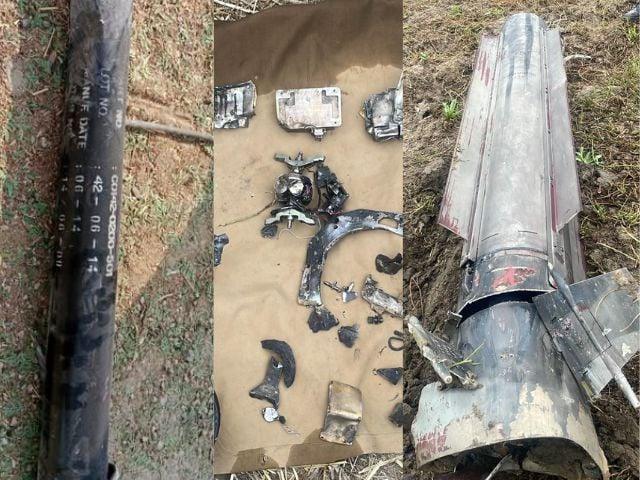The Pakistani army intercepted and destroyed 77 drones of Israeli manufacture, sent by India to target civil and military facilities, security sources announced on Friday.
At least the drones were intercepted from Wednesday until Thursday evening, with an additional 48 slaughtered overnight and Friday, added the source.
On the control line (LOC), security sources said, five civilians were martyred and seven others injured in Indian bombing not caused in residential areas.
The bombings have targeted the areas of Hajeera, striker Kahuta and Khuiratta using heavy artillery, causing civilian victims and structural damage, they say.
Indian forces use heavy artillery to target civilian populations along the loc, according to security sources. The bombings caused a strong and immediate response from the Pakistani army, he added.
According to security sources, Indian troops also raised a white flag near Dharamsal 2 after the opposite battle sector after reprisals supported by the Pakistani army.
Pakistani army officials stressed that any assault along the loc will be welcomed with a quick and effective response.
Tensions between India and Pakistan increased sharply following a series of events that started with a deadly attack in Pahalgam, located in Jammu-et-Cachemire illegally Indian (IIOJK), on April 22.
The attack made 26 lives, mainly tourists. India blamed the incident on elements based in Pakistan, although no supporting evidence has been published publicly. Pakistan strongly denied allegations.
In response to Pahalgam’s attack, India has taken a series of diplomatic and administrative actions, in particular the closure of the Wagah-Attari lands, the suspension of the Industry Water Treaty and the revocation of Pakistani visas on April 23. Pakistan responded to an act of war.
Hostilities intensified in the night of May 6 to 7, when the Indian armed forces had carried out coordinated missiles, aerials and drones in several places in Pakistani territory. The targeted areas included Sialkot, Shakargarh, Muridke and Bahawalpur in Punjab, as well as Kotli and Muzaffarabad in Azad Jammu and Cachemire (AJK).
According to inter-service public relations (ISPR), the attacks resulted in at least 31 civilians, including women and children, and have been 71 other injured. Civil infrastructure, such as mosques and the Neelum – Jhelum hydroelectric project, has also suffered damage.
In a reprisal operation, the Pakistani army reported the decrease of five Indian Air Force planes and a combat drone. The plane was identified as three burst jets, a MIG-29, a SU series jet and an Israeli manufacturing heron drone, which would have been shot in areas such as Bhatinda, Jammu, Akhoror, Srinagar and Avantipur.
Learn more: “Will avenge each drop of martyrs’ blood,” warns India
What is HAROP?
According to a report by Times of Israel, the HAROP, manufactured by Israel Aerospace Industries, is an ammunition which can fly to targets and then attack them by crushing them at the origin of the operator, destroying himself in the process.
The HAROP is equipped with electro-optical, infrared (IR) and prospective (FLIR) infrared sensors, as well as a color CCD camera and anti-radar return capacities, providing target detection and identification, indicates a ratio of the Eurasian Times.
He also indicates that Harop can seek targets in an area designated for nine hours, locate and identify them, plan a path of attack, then continue the strike of any direction at shallow or steep diving angles. Due to his immunity to the shock of the GNSS, HAROP overcomes communication challenges.
Launched from canistères mounted on trucks or naval ships, HAROP is easily deployed from various land and environments. The drone will return to the base if a target is not engaged. It was designed to minimize its radar signature by stealth (low observability).
Why did India used HAROP?
According to Pakistani security sources, the Indian Air Force (IAF) could hesitate to launch other inhabited air missions after losing five of its warparts in the air combat with PAF at night between May 6 and 7.
They also declared that India was trying to divert the attention of its military setbacks with such provocative actions to appease the domestic public. The army said that it had remained on a high alert, responding to each act of aggression with a “firm and proportionate” approach.
It was a huge discomfort for India when he threw a missile strike on Pakistan, but lost five of his jets, including three modern dumping planes, in aerial combat during PAF’s reprisals. New Delhi has not officially confirmed the drop in burst jets.
However, a senior French intelligence official confirmed to CNN that a burst aircraft had indeed been killed by Pakistan, marking the first time that one of these advanced French planes had been lost in combat.
An American commentator from CNN pointed out that the potential loss of Rafale planes would have a significant blow to the claim of the air superiority of India, which it had built around the induction of these war aircraft of French manufacturing.
Some experts have suggested that the confrontation between the two countries served as a test of Chinese and Western military technologies, in particular after Pakistan acquisition of China J-10C jets in response to the Rafale Fleet of India. Analysts noted that Chinese J-10C jets are very effective, potentially deploying the regional balance of powers.




